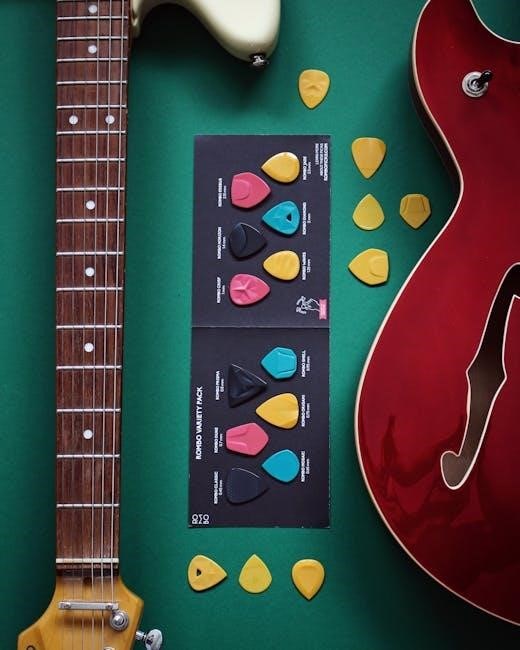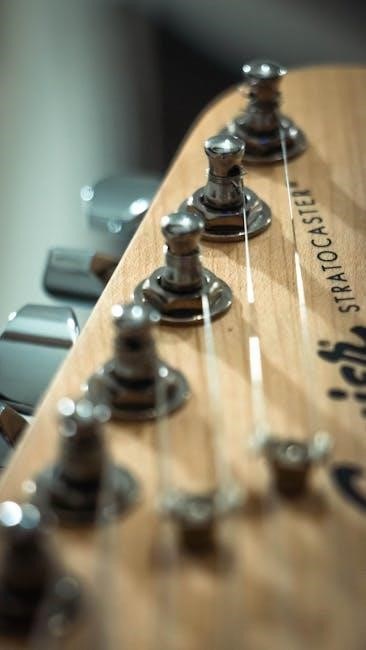Electric guitar strings offer a wide variety of tonal possibilities, with differences in gauge, material, and construction affecting playability and sound. Choosing the right set is crucial for optimal performance and personal satisfaction, as they directly impact both tone and feel. Understanding the basics of string types, gauges, and materials helps guitarists tailor their sound and style, ensuring the best playing experience.
Importance of Choosing the Right Strings
Choosing the right electric guitar strings is essential for achieving your desired tone, playability, and overall performance. The wrong strings can lead to poor sound quality, discomfort while playing, and even damage to your guitar. Different gauges and materials significantly impact how the guitar sounds and feels, making it crucial to select strings that align with your playing style and musical genre. Whether you prioritize brightness, sustain, or ease of bending, the right strings will enhance your musical expression and personal preference, ensuring a more enjoyable and rewarding playing experience.
Overview of String Types and Materials
Electric guitar strings come in various types and materials, each offering distinct tonal and tactile characteristics. Nickel-plated steel strings are the most common, providing a warm, balanced sound. Stainless steel strings offer brightness and durability, while pure nickel strings deliver a vintage tone. Coated strings, like Elixir’s Optiweb, resist corrosion and last longer. Flat-wound strings produce a smooth, mellow sound, ideal for jazz, whereas round-wound strings are brighter and more versatile. Understanding these differences helps players select strings that match their musical style and personal preference, enhancing both sound and playability.

Understanding String Gauges
String gauges refer to the thickness of guitar strings, ranging from light to heavy. Lighter gauges (e.g., 9-42) offer easier bending and brighter tones, while heavier gauges (e.g., 11-49) provide more sustain and a fuller sound, making them ideal for different playing styles and musical genres.
What Are String Gauges?
String gauges are measurements of a guitar string’s thickness, typically expressed in thousandths of an inch. They range from lighter gauges, such as 0.009 inches for the high E string, to heavier gauges, like 0.042 inches for the low E string. Each string set combines specific gauges to balance playability and tone. Lighter gauges are easier to bend and provide a brighter sound, while heavier gauges offer more sustain and a warmer tone, making them suitable for different playing styles and musical genres. Understanding gauges helps guitarists choose the right strings for their needs.
How Gauge Affects Tone and Playability
String gauge significantly influences both tone and playability. Lighter gauges (e.g., 0.009-0.042) are easier to bend and fret, offering a brighter, snappier sound, ideal for lead and rhythm playing. Heavier gauges (e.g., 0.011-0.049) provide more sustain and a fuller, warmer tone, often preferred by rhythm and jazz players. However, heavier strings can be harder on the fingers and may require adjustments to playing technique. The right gauge balances comfort, tone, and performance, making it essential to choose based on your musical style and personal preference for optimal results.
Choosing the Right Gauge for Your Playing Style
Selecting the appropriate string gauge is crucial for optimizing your playing experience. For lead guitarists and those who frequently bend strings, lighter gauges (0.009-0.042) are ideal, offering ease of playability and flexible bending. Rhythm players and those seeking heavier tones may prefer medium gauges (0.010-0.046) for balance. Heavier gauges (0.011-0.052) suit jazz and hard rock styles, providing sustain and a robust sound. Consider your technique, musical genre, and desired tone to choose the gauge that best complements your style and enhances your performance.

Materials and Construction of Electric Guitar Strings
Electric guitar strings are typically made from nickel-plated steel, pure nickel, or stainless steel, with a steel core wrapped in another material for tone and durability.
Nickel, Steel, and Other Materials
Electric guitar strings are primarily made from nickel-plated steel, pure nickel, or stainless steel. Nickel-plated steel strings offer a balanced tone with warmth and clarity, making them a popular choice. Pure nickel strings provide a vintage, warmer sound often preferred by classic rock and blues players. Stainless steel strings are durable and bright, ideal for aggressive playing styles. Other materials, like titanium or coated strings, enhance longevity and tone. Each material affects the string’s feel, sustain, and overall sound, allowing players to customize their guitar’s voice to suit their musical style and preferences.
Coated vs. Uncoated Strings: Pros and Cons
Coated strings, such as Elixir’s Optiweb, feature a protective layer that extends lifespan by resisting dirt and oils. They offer a smooth feel and consistent tone but may lack the brightness of uncoated strings. Uncoated strings provide a vibrant, dynamic sound and a more direct playing experience but are prone to corrosion and wear faster. Coated strings are ideal for players seeking longevity, while uncoated strings suit those prioritizing tone and tactile response. The choice depends on balancing durability, tone, and personal preference in playability.
String Winding Methods
String winding methods significantly impact tone and feel. Round-wound strings offer brightness and versatility, while flat-wound strings provide a smooth surface for genres like jazz.
Round-Wound vs. Flat-Wound Strings
Round-wound strings, the most common type, feature a textured surface that produces a bright, punchy tone with good sustain. Flat-wound strings, with their smooth surface, offer a mellow, smooth tone and a faster playing feel, ideal for jazz and funk. The choice between them depends on the desired sound and playing style, making each suitable for different genres and preferences. This distinction helps guitarists select strings that match their artistic needs and deliver the desired musical impact.
Other Winding Types and Their Effects
Beyond round- and flat-wound strings, there are lesser-known winding types that offer unique tonal characteristics. Half-wound strings combine round and flat windings, providing a balanced tone with reduced finger noise. Tape-wound strings, wrapped with a flat tape, deliver a smooth, mellow sound and are ideal for jazz. Pressure-wound strings are smoother than round-wounds but not as flat as tape-wounds, offering a compromise between tone and playability. Each winding type caters to specific musical genres and playing styles, allowing guitarists to experiment and find the perfect match for their sound.

Best Electric Guitar String Brands
Prominent brands like Ernie Ball, Elixir, and D’Addario dominate the market, offering high-quality strings with unique features. Ernie Ball’s Slinkys are a favorite, while Elixir’s coated strings provide longevity, and D’Addario’s XL series delivers exceptional tone and durability.
Ernie Ball: Slinkys and More
Ernie Ball is a legendary brand renowned for its high-quality electric guitar strings. Their iconic Slinkys are a favorite among players, offering a balanced tone and exceptional durability. Available in a wide range of gauges and materials, including nickel, steel, and stainless steel, Ernie Ball strings cater to diverse playing styles. From lighter gauges for bendable leads to heavier gauges for full-bodied rhythm, Slinkys deliver consistent performance. Ernie Ball’s commitment to innovation and quality has made them a go-to choice for professional musicians and enthusiasts alike, ensuring a rich, vibrant sound for any musical genre.
Elixir: Coated Strings for Longevity
Elixir strings are celebrated for their innovative Nanoweb and Optiweb coatings, which extend string life and maintain tone. Unlike traditional uncoated strings, Elixir’s coated options resist corrosion and oil from fingers, preserving brightness and clarity. Their Nanoweb coating offers a smooth feel, while Optiweb provides a natural, uncoated playability. Elixir strings are ideal for players seeking longevity without compromising on sound quality. Their durability makes them a popular choice for touring musicians and those who want less frequent string changes while retaining a fresh, vibrant tone.
D’Addario: XL Series and Other Options
D’Addario is a renowned brand offering high-quality strings for electric guitars. Their XL Series stands out for its exceptional tone and durability, featuring nickel-plated steel construction for a warm, balanced sound. The XL Series is available in various gauges, catering to diverse playing styles. D’Addario also offers specialized options like NYXL, known for their strong, break-resistant design and smooth playability. With a commitment to innovation and consistency, D’Addario strings are a reliable choice for musicians seeking reliability and versatility in their sound.
Other Notable Brands
Beyond the major brands, several other manufacturers offer exceptional electric guitar strings. GHS Strings are known for their high-quality, USA-made products, providing a bright tone and durability. Fender offers strings designed specifically for their iconic guitars, ensuring compatibility and optimal performance. Warwick and La Bella also produce unique sets tailored for particular sounds and playing styles. These brands provide versatile options for guitarists seeking distinct tones or specific musical genres, ensuring there’s a perfect match for every player’s unique needs and preferences.

Factors Influencing Your String Choice
Your playing style, guitar type, musical genre, and personal tone preferences are key factors in selecting electric guitar strings. Each element shapes the sound and feel you achieve.
Playing Style: Lead, Rhythm, or Both
Your playing style significantly impacts your string choice. Lead players often prefer lighter gauges (e.g., 9-42) for easier bending and brighter tones, while rhythm players may opt for heavier gauges (e.g., 11-49) to achieve fuller sustain and chunkier chords. Hybrid players who switch between lead and rhythm may find a medium gauge (10-46) strikes a balance. Understanding your style helps tailor your string selection to enhance playability and tone, ensuring the best performance for your musical approach.
Guitar Type: Bridge and Hardware Considerations
Your guitar’s bridge and hardware play a crucial role in string selection. Fixed bridges generally work well with most string gauges, while tremolo systems may require specific gauges to maintain tuning stability. String tension and gauge must align with your guitar’s setup to avoid issues like buzzing or poor sustain. Additionally, hardware materials (e.g., steel or nickel) can interact with strings to produce distinct tones. Always consider your guitar’s specifications and consult the manufacturer’s recommendations to ensure compatibility and optimal performance.
Musical Genre: Rock, Jazz, Blues
Electric guitar strings are often chosen based on the musical genre. Rock players may favor heavier gauges for powerful chords and sustain, while jazz musicians prefer lighter gauges for smooth, intricate lines. Blues guitarists often opt for versatile, medium gauges that balance tone and playability. Coated strings can enhance clarity in jazz, while uncoated strings provide the bright, crisp tones desired in rock. Steel strings offer brightness ideal for rock, nickel strings provide warmth for blues, and flat-wound strings suit jazz for smooth tones. The right string choice helps achieve the desired sound for your genre.
Personal Preference: Tone and Feel
Personal preference plays a significant role in selecting electric guitar strings. Tone and feel are subjective, with players seeking strings that match their musical style and comfort. Some prefer the bright, crisp sound of steel strings, while others favor the warmth of nickel. Coated strings offer durability and reduced finger noise, appealing to those who value longevity. Gauge also impacts feel, with lighter strings being easier to bend and heavier strings providing firmer tension. Experimentation is key to finding the perfect balance of tone and playability that suits individual preferences and enhances the overall playing experience.
Installing and Maintaining Your Strings
Proper installation and maintenance ensure optimal performance and longevity. Change strings regularly, stretch them thoroughly, and clean them to prevent corrosion and maintain tone quality effectively.
How to Change Your Strings Properly
Changing electric guitar strings requires careful attention to detail. Start by loosening the old strings with a tuner or by playing them softly. Remove the old strings one at a time to avoid confusion. Install the new strings, ensuring they are the correct gauge and type for your guitar. Wind them neatly around the tuning pegs, leaving minimal slack. Stretch the strings by gently pulling them away from the fretboard to prevent slippage. Tune your guitar immediately after installation and recheck tuning after stretching. Properly dispose of the old strings to maintain a clean setup.
Stretching and Setting Up Your Strings
After installing new strings, stretching is essential to stabilize tuning. Hold the guitar by the neck and gently pull each string away from the fretboard, repeating this process several times. This reduces slippage and prevents frequent tuning adjustments. Once stretched, tune your guitar and check the action to ensure the strings are at a comfortable height. Adjust the bridge or nut if necessary for optimal playability. Proper setup ensures your guitar sounds its best and feels great to play, making the stretching process a crucial step in maintaining your instrument’s performance and longevity.
Pros and Cons of Different Gauges
Lighter gauges offer easier playability and brighter tones but may lack sustain. Heavier gauges provide richer sound and sustain but can be harder to bend. Choose based on your style and preference for the best balance of tone and comfort.
Lighter Gauges: Ease of Playability
Lighter gauges (e.g., 0.009–0.042) are ideal for players seeking ease of playability. They reduce finger fatigue and make bending strings easier, especially for lead guitarists. The lighter tension allows for faster solos and a brighter, more agile tone, making them perfect for rock, pop, and jazz. However, lighter strings may lack sustain and can produce a thinner sound compared to heavier gauges. They are also more prone to buzzing if the guitar’s action isn’t properly set. Lighter gauges are great for beginners or those with a lighter touch, offering a comfortable playing experience while still delivering crisp, vibrant tones.
Heavier Gauges: Sustain and Tone
Heavier gauges (e.g., 0.011–0.049) deliver exceptional sustain and a richer, fuller tone, making them ideal for rhythm players and those seeking a robust sound. The increased string tension produces a warmer, more resonant quality, with enhanced low-end clarity. Heavier strings are often preferred in genres like rock and metal, where powerful tones are essential. However, they require more finger strength and can be challenging for lead work. Proper setup is crucial to avoid buzzing and ensure smooth playability. Heavier gauges are perfect for players prioritizing tone and sustain over ease of playability, offering a dynamic and expressive sound.
Pros and Cons of Different Materials
Nickel strings offer warmth and sustain, while steel strings provide brightness and clarity. Stainless steel strings last longer but can sound harsh. Choose based on tone and durability needs.
Nickel Strings: Warmth and Sustain
Nickel strings are renowned for their warm, vintage tone and exceptional sustain, making them a favorite among jazz, blues, and classic rock players. They produce a smooth, balanced sound with a slightly softer feel compared to steel strings. This makes them ideal for rhythm playing and intricate melodies. However, they can lack the brightness of steel strings, which may not suit genres requiring sharp, cutting tones. Coated nickel strings, like Elixir’s Optiweb, offer extended lifespan without sacrificing the signature warmth. For players seeking a rich, full-bodied sound, nickel strings are a timeless choice.
Steel Strings: Brightness and Clarity
Steel strings deliver a bright, crisp tone with excellent clarity, making them perfect for genres like rock, metal, and modern pop. They provide a sharp, snappy response, ideal for lead solos and cutting through dense mixes. Compared to nickel strings, steel strings offer enhanced articulation and a more aggressive sound. However, they can feel stiffer and may lack the warmth of nickel. Stainless steel strings, known for their durability, retain their brightness longer but can be harsh on the fingers. For players seeking a bold, dynamic sound, steel strings are the optimal choice, balancing clarity with powerful projection.

Common Mistakes to Avoid
Using the wrong string gauge for your style, neglecting regular string maintenance, and improper installation techniques are common errors that can hinder tone and playability. Avoid these pitfalls to ensure optimal performance and longevity of your strings. Proper care and attention to detail will enhance your overall guitar experience. Always research and choose strings that align with your musical goals and preferences for the best results. Happy playing! Guitarists often overlook the importance of string quality and setup, which can significantly impact sound and comfort. Be mindful of these factors to elevate your music. Choosing the right strings is essential for achieving your desired tone and feel. Experiment with different options to find your perfect match. Regular string changes and proper stretching are crucial for maintaining consistent playability and tone. Don’t underestimate the impact of fresh strings on your sound. Electric guitar strings come in various materials and gauges, each offering unique characteristics. Selecting the right set requires considering your playing style, genre, and personal preference. Lighter gauges are easier to bend but may lack sustain, while heavier gauges provide fuller tone but can be harder to play. Coated strings offer longevity but may differ in feel. Balance your needs to find the ideal strings for your music. Many players overlook the importance of string winding type, which affects tone and playability. Round-wound strings are common, while flat-wounds suit specific styles. Explore these options to tailor your sound. Understanding string materials is vital; nickel offers warmth, steel provides brightness, and coated strings last longer. Choose wisely to match your sound preferences. Guitarists often use the same strings for all styles, which can limit their tone. Experiment with different sets to optimize your sound for each genre. Neglecting string maintenance leads to tone loss and corrosion. Clean and condition your strings regularly to preserve their quality and lifespan. Incorrect string installation can cause tuning issues and reduce playability. Learn proper techniques to ensure your guitar performs at its best. Using inappropriate gauges for your style can lead to poor tone and discomfort. Match your playing technique with the right gauge for better results. Overlooking personal preference in string feel and tone can hinder your enjoyment. Prioritize what feels and sounds best to you as a player. Electric guitar strings are a key component of your sound. By avoiding common mistakes and making informed choices, you can unlock your guitar’s full potential. Experiment with different brands and types to discover your ideal strings. Proper string care and selection will elevate your playing experience and ensure your guitar sounds its best. Avoiding these common errors will help you achieve the tone and playability you desire. Happy playing! Guitarists often overlook the importance of string quality and setup, which can significantly impact sound and comfort. Be mindful of these factors to elevate your music. Choosing the right strings is essential for achieving your desired tone and feel. Experiment with different options to find your perfect match. Regular string changes and proper stretching are crucial for maintaining consistent playability and tone. Don’t underestimate the impact of fresh strings on your sound. Electric guitar strings come in various materials and gauges, each offering unique characteristics. Selecting the right set requires considering your playing style, genre, and personal preference. Lighter gauges are easier to bend but may lack sustain, while heavier gauges provide fuller tone but can be harder to play. Coated strings offer longevity but may differ in feel. Balance your needs to find the ideal strings for your music. Many players overlook the importance of string winding type, which affects tone and playability. Round-wound strings are common, while flat-wounds suit specific styles. Explore these options to tailor your sound. Understanding string materials is vital; nickel offers warmth, steel provides brightness, and coated strings last longer. Choose wisely to match your sound preferences. Guitarists often use the same strings for all styles, which can limit their tone. Experiment with different sets to optimize your sound for each genre. Neglecting string maintenance leads to tone loss and corrosion. Clean and condition your strings regularly to preserve their quality and lifespan. Incorrect string installation can cause tuning issues and reduce playability. Learn proper techniques to ensure your guitar performs at its best. Using inappropriate gauges for your style can lead to poor tone and discomfort. Match your playing technique with the right gauge for better results. Overlooking personal preference in string feel and tone can hinder your enjoyment. Prioritize what feels and sounds best to you as a player. Electric guitar strings are a key component of your sound. By avoiding common mistakes and making informed choices, you can unlock your guitar’s full potential. Experiment with different brands and types to discover your ideal strings. Proper string care and selection will elevate your playing experience and ensure your guitar sounds its best. Avoiding these common errors will help you achieve the tone and playability you desire. Happy playing!
Inappropriate Gauge for Your Style
Using the wrong string gauge can hinder your playing experience and tone. Lighter gauges (e.g., 9-42) are ideal for bending and faster solos, while heavier gauges (e.g., 11-49) offer sustain and chunky rhythms. Choosing a gauge that doesn’t match your style can lead to fatigue or a lackluster sound. For example, heavy gauges can be challenging for lead players, while light gauges may lack the punch needed for rhythm playing. Always consider your musical style and playing technique when selecting a gauge to ensure optimal tone and comfort.
Neglecting String Maintenance
Neglecting string maintenance can significantly impact both tone and playability. Dirt, oil, and grime accumulate on strings, dulling their brightness and sustain. Failing to clean or condition strings can lead to corrosion and premature wear. Regular cleaning with a soft cloth or string cleaner prevents buildup and extends string life. Additionally, ignoring string stretching after installation can cause tuning instability. Proper maintenance ensures consistent performance and sound quality, making it a crucial part of guitar care. Keep your strings clean and conditioned to maintain their optimal tone and longevity.
Incorrect Installation Techniques
Incorrect installation of electric guitar strings can lead to tuning issues, reduced playability, and shortened string life. Common mistakes include improper winding around the tuning machines, insufficient stretching, and poor cutoff of excess string ends. These errors can cause uneven tension, leading to tuning instability and potential string breakage. Additionally, not seating the strings properly in the nut and bridge can result in poor intonation and a less responsive instrument. Taking the time to install strings correctly ensures better performance, tone, and longevity, making it a critical step in guitar maintenance.
Choosing the right electric guitar strings significantly impacts tone and playability. Experiment with gauges, materials, and brands to find your ideal sound. Happy playing!
Final Tips for Choosing the Best Strings
Experiment with different gauges and materials to find your ideal tone and feel. Consider your playing style and guitar type when selecting. Lighter gauges are great for bending, while heavier gauges offer more sustain. Nickel strings provide warmth, while steel strings deliver brightness. Coated strings last longer but may lack the brightness of uncoated ones. Try brands like Ernie Ball, D’Addario, or Elixir to experience varying qualities. Ultimately, trust your ears and fingers—your sound is personal. Don’t hesitate to explore until you find the perfect match for your music and style.
Encouragement to Experiment and Find Your Sound
Exploring different strings is a journey of discovery that enhances your musical identity. Don’t be afraid to try various gauges, materials, and brands to uncover the tone that resonates with you. Every string set offers unique characteristics, from the brightness of steel to the warmth of nickel. Coated strings might suit your needs for longevity, while uncoated strings deliver raw clarity. Embrace the process, as it’s through experimentation that you’ll find the perfect match for your playing style and musical genre. Your sound is unique, and the right strings will help you express it fully. Keep exploring and enjoy the evolution of your sound!

Additional Resources
Explore our curated list of guides, tutorials, and forums to deepen your knowledge of electric guitar strings. Find expert tips, video demos, and community discussions to enhance your journey.
Recommended Reading and Guides
For a deeper understanding of electric guitar strings, explore comprehensive guides that cover material types, gauges, and winding methods. Check out detailed tutorials on string installation and maintenance, along with tone-enhancing tips. Video demonstrations provide step-by-step instructions for changing strings and adjusting setups. Additionally, forums and communities share real-world experiences, helping you avoid common mistakes. These resources offer invaluable insights, ensuring you make informed decisions tailored to your playing style and musical goals. They’re perfect for both beginners and seasoned players looking to refine their sound and technique.
Video Tutorials for String Changing
Video tutorials are an excellent resource for mastering the art of changing electric guitar strings. They provide clear, step-by-step instructions, making the process easier for both beginners and experienced players. Many tutorials cover topics like proper string winding, bridge setup, and stretching techniques to ensure optimal playability. Additionally, videos often include tips for maintaining your guitar’s action and tone. Platforms like YouTube offer a wide range of guides, from basic demonstrations to advanced methods. These visual aids help you avoid common mistakes and ensure your guitar sounds its best after a string change.
Online Communities for Discussion
Online forums and communities are invaluable for discussing electric guitar strings. Platforms like Reddit, Guitar World forums, and specialized music groups offer spaces to share experiences, ask questions, and learn from seasoned players. These communities provide insights into string preferences, troubleshooting, and tips for optimizing your setup. Engaging with others helps you discover new brands, gauges, and techniques tailored to your playing style. Active participation in these forums can enhance your understanding and help you make informed decisions when choosing the right strings for your electric guitar.